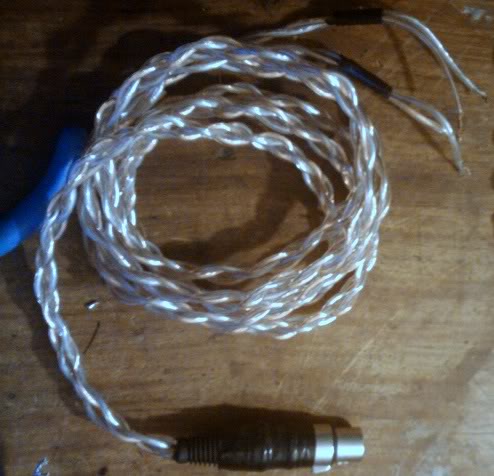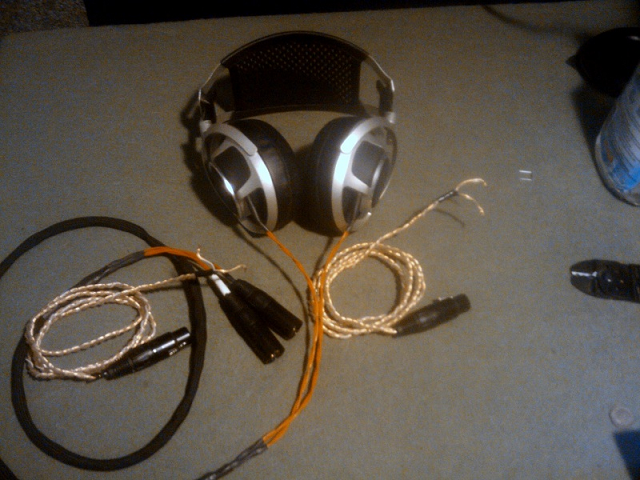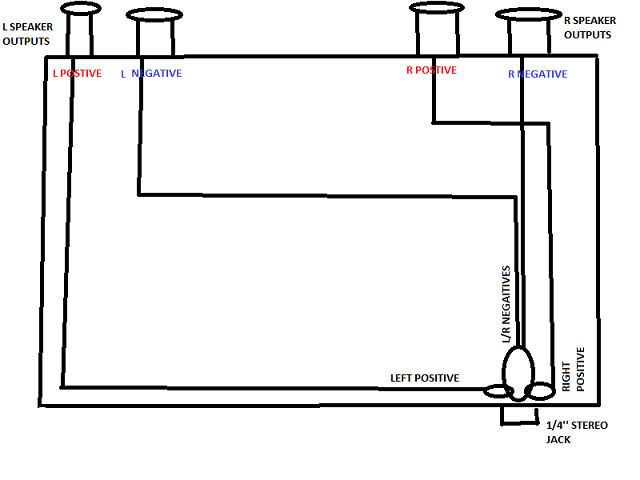this is just copy and past from last night. would of shared is sooner but kinda fell asleep lol. anyhoo....
alrighty then. i been wanting to make this for some time now but been kinda busy. first i'm no expert in electrical engineering or a master DIY'er. i just experiment and go by instinct most of the time and i do lot of reading on things i'm interested in to find out and learn.
i only know 3 methods so far but before that there is a few things. i only recommend very high impedance or very low-sensitive headphones cause you might run into gain issues and large amount of background noise depending on your amp's S/n ratio(anything above 100db is great) since they were of course design around speaker driving and their gain(voltage) tends to be much higher than just about any headamp so background hiss might be an issue to some but just about any headphone can be driven from speaker outputs without issues really. anyhoo, this is only methods i done but it mostly involves diy so if you don't mind using a solder gun then this should be pretty straight forward.
rewiring the headphone: ok, this seem pretty much common sense here but this is pretty much one method to get it done. most headphones use a 3-core wiring scheme. positive and negative and a common ground is shared between each channel to split up the stereo signal.
in order to hook them up to speaker outputs your gonna have to eliminate that common ground and re-wire the headphone with 4-core wiring(4 wires) meaning each channel will have a positive and negative(like speakers) and what happens is the negatives also will act as a ground as well so it's not necessary to add any more wires for a separate ground. i use just bare speaker wire of my choice from any store and just braid it but 4-core mogami wire seems very popular as well.
re-terminating headphone: some headphones already have 4-core wiring integrated into a 1/4'' TRS jack. all you have to do is cut the ends and you can either hook it directly to the speaker outs or you can terminate it with the fellowing connectors below
4-pin XLR: this is probably one of the easiest to do in my opinion. first headphone to ever use this connection was the K1000 due to their massive low sensitivity and being pretty powered hungry for a dynamic headphone. for wiring the connector i used the k-1000 manual as a point of reference cause it has the diagram for the 4-pin xlr. in my opinion the k-1000 is probably the first and best method to use if you need wiring info. if you can't get the manual in anyway, heres the wiring configuration
4-pin XLR connector pins:
3 - Right +
4 - Right -
1 - Left +
2 - Left -
you terminate the headphone with a male 4-pin xlr jack(can be complete rewire or if your headphone is already using 4-core wiring). then you just make a female 4-pin xlr to bare wire adapter. you don't have to add any banana connectors or spades or whatever. it can be just bare wire ends but you can add whatever connector at the end of your choice if you like and done like this:

Dual 3-pin XLR:
this is probably one of the weirdest wiring configurations for headphones if you personally ask me, but anyways...
first of course the headphone has to already have 4-core wiring or you're gonna have to rewire the headphone for 4-core wiring use. this method to novices might actually be less of a hassle to some if they're not up to snuff with soldering cause for each channel you only need to solder 2 wires instead of 4. wiring configuration:
3-pin XLR:
1 - nothing
2 - positive
3 - negative(the negative wi
ll also act as a ground)
for each xlr jack and done like this

like to note dual 3-pin configuration is only possible making the headphone dual-ended. 4-pin xlr can be either single sided or dual ended on matter what you prefer.
speaker box:
this method can be done to prevent rewiring your headphone or completely re-terminating it. you can DIY or there is some online(not just hi-fi mans'). i beleive koss made a lot of headphone out to speaker out boxes.
for diy is bit pretty much straight forward and pretty easy if you don't mind soldering and drilling. local parts can be picked up simply by your local radioshack for about 40 bucks or bit less depending on location and your choice of parts and of course if you need a solder gun as well.
how i did it was very basic since i wanted to use the full force of my power amps when i test out loaner pairs on how they respond to speaker outputs(also cause speaker outs have close to or a 0ohm output impedance). all i did was solder straight wire from the 1/4'' trs female jack to the speaker post like this:

you can of course add resistors in the path and usually reccomended to most people to limit down the power from the power amp but for me found it pretty much pointless since my receivers and amps already used resistors between the headphone jack and power amp section and i just be going back from where i started and all i can do is just change the resistors in the amp instead but don't take this wrong way though. using resistors to limit the power and give a specific output impedance of your choice is really great and allows lot of experimentation at your disposal and it will help solve any gain issues you might run to or eliminate hiss if your power amp does not have input gain controls. there is a site here showing how to do it:
http://sound.westhost.com/project100.htmthing i want to mention and this is very,very,very,very important and can't stress myself enough to keep mentioning it to people and from dumb mistakes i learned in the pass. make sure your amp has a common ground! if your amp does not have a common ground you will end with the possibility of killing not only your amp but your headphones as well. easy way for you to check is the schematics. don't worry it's usually very simple and obvious to see so anyone should be able to spot it but easy way to tell is if the negatives to your speaker outputs are tied together, basically meaning there will be a straight line from the left negative to right negative showing it's tied together.
well that's all i know. i know i promised someone week ago but my procrastination got the best of me and because i been too ocupied enjoying pair of loaner stax 2020 basic II system a very kind person has loaned me to audition for couple months. he's my butt buddy for life lol.
if anyone else knows anything and want to ad then i very much welcome and encourage it cause like i said i'm not master DIY'er so i still have tons more to learn so please share!
EDIT: i forgot to note for tube amps you might need to put a resistor in the path to allow the amp to see a specific output impedance cause tubes are transformer coupled. my box is only good cause i only use solid-state amps so output impedance and the impedance of the headphone is not a big deal.
EDIT 2:i forgot to mention also it's only important your amp has a common ground if you using a speaker box. reason why cause the 2 negatives are/will be tied together and will act as a double common g
round so making sure the amp is common ground as well is important. if your headphone is already or rewired with the other configurations above then you do not need to worry cause the negatives are separated when using 4-core wiring method.


